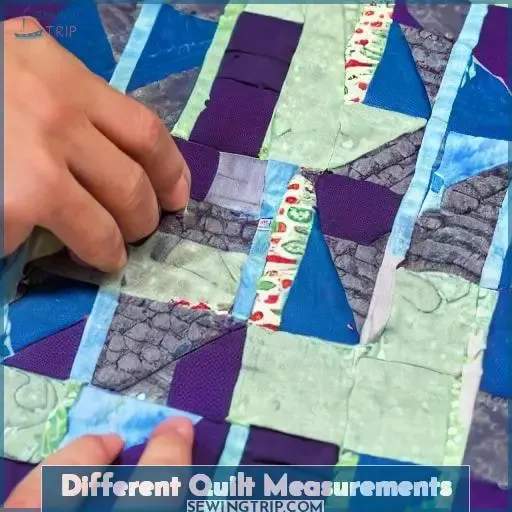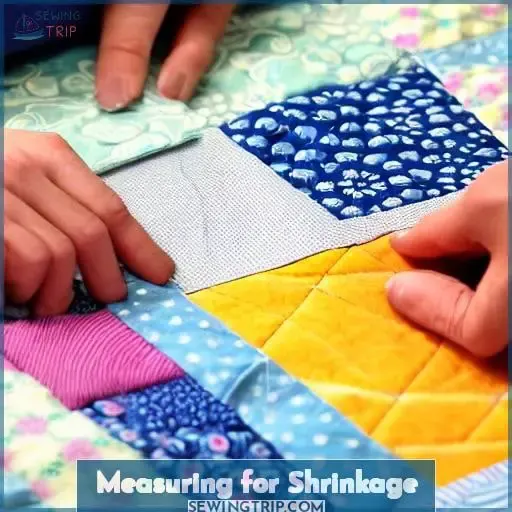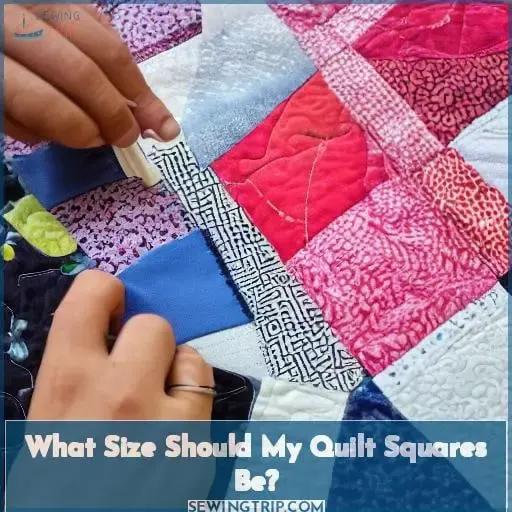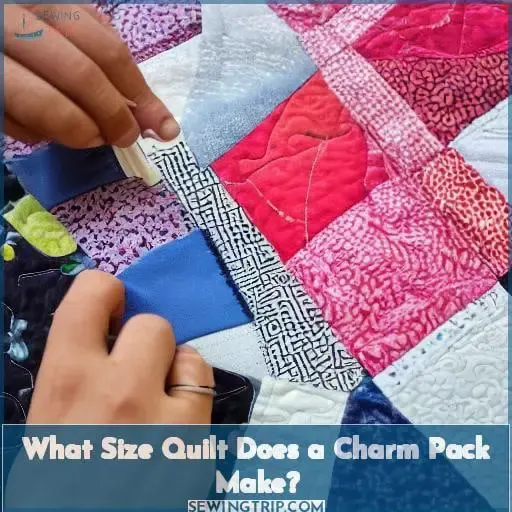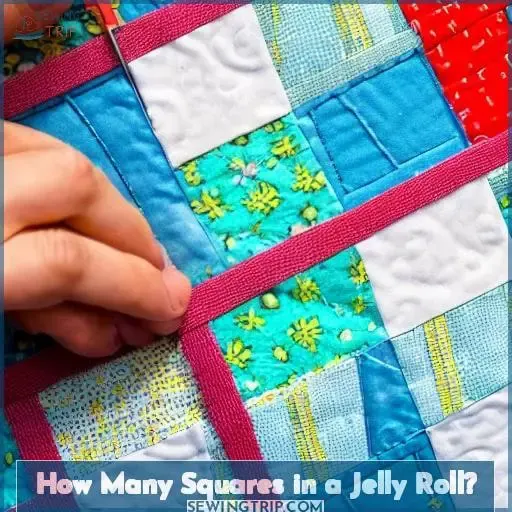This site is supported by our readers. We may earn a commission, at no cost to you, if you purchase through links.
Are you an avid quilter? Do you know how many 5-inch charm squares it takes to make a perfect quilt? If not, then this article is for you! Quilting is an art form that requires careful planning and precision. To create the beautiful blankets of your dreams, mastering the skill of determining how many 5-inch squares are needed for each size quilt is essential.
Follow some basic guidelines and have a keen eye for detail to calculate the number of charm squares required. It’ll become second nature in no time! Read on to learn more about creating gorgeous handmade creations with ease!
Table Of Contents
Standard Quilt Sizes
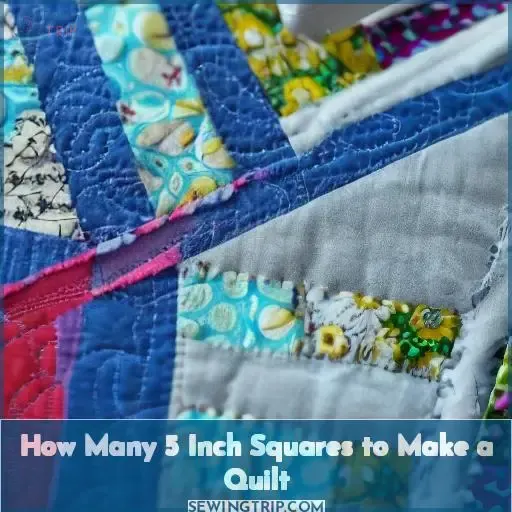
To create a quilt of any size, simply calculate the length and width of your desired finished project and divide by 4.5 to determine how many charm squares you’ll need! This will make sure you have enough fabric for your quilting project.
When selecting fabric, consider patterns suited to charm packs or jelly rolls, as well as traditional yardage. This way, you can easily choose fabrics that coordinate.
Quilters have an array of block patterns they can use – from classic Nine Patch blocks to intricate Drunkard’s Path designs. So, select a pattern before purchasing materials based on standard measurements such as those for:
- Baby blankets (31.5 x 40.
- Throw blankets (54 x 67.
- Twin-size beds (72 x 90.
- Full-sized beds (85 ½ x 108.
- Queen-sized bedding with pillow tucks (90 x 108.
- King sized bedding with pillow tucks (112 ½ x 108.
With these tips in mind, it’s easy for even beginners in the crafty world of sewing and crafting projects using charming five inch squares!
How to Determine Number of Squares for Quilt Size
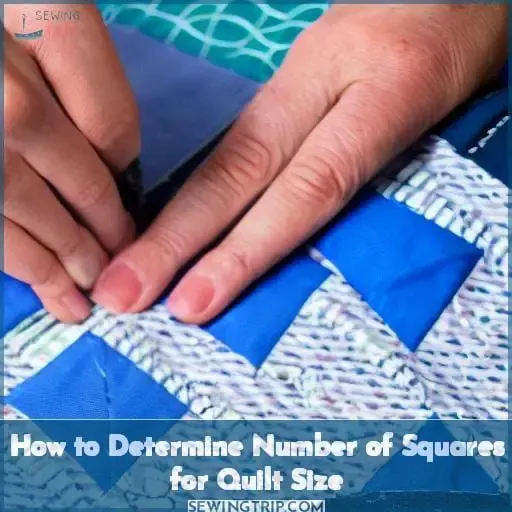
When it comes to determining the number of squares for quilt size, consider these important factors: finished square size, seam allowance, and borders.
Subtract the seam allowance from 5 inches, then divide by 4.5 inches to get an accurate indication of how many charm packs or jelly rolls are needed.
Don’t forget to account for sashing or border fabric. This’ll ensure you have enough material.
Finished Square Size
Determine the perfect size for your quilting project by subtracting seam allowance from the starting measurement and dividing finished dimensions by 4.5 inches! Modular patchwork, quilting techniques, pieced blocks, fabric selection and quilting tools are all elements of successful charm square projects. Baby quilts require fewer charm squares than larger projects because they measure a smaller area; however, standard charm packs will not easily create a twin or full-sized bedspread due to their 42-piece count.
Consider using jelly rolls instead as two can make an impressive 64×88 throw blanket! If you’re seeking versatility with fewer pieces, opt for half-square triangles which offer unique patterns in any size while still leaving room for sashing or borders if desired.
Lastly, be sure to account for shrinkage when selecting fabrics since this could affect how many squares are needed in order to achieve optimal results on your next masterpiece!
Seam Allowance
You must factor in seam allowance when calculating the fabric pieces needed for your quilt. Seam allowances vary depending on the basting technique, quilting template, piecing method, block designs, and fabric used.
A charm pack contains 42 5-inch blocks, and a fat quarter yields 4 five inch squares – so calculate how many you need for your project before you start cutting.
Knowing the exact number of charm squares needed for each size quilt is essential. Subtracting the seam allowance from the starting measurement of 5 inches will help determine this total number.
For example, if you’re making a baby sized blanket measuring 31 x 40 inches, you’ll need 63 five-inch squares after subtracting 1/4 inch seam allowances from all sides. Half square triangles can increase this total amount even more.
Borders
Adding a border to your quilt can take it from drab to fab in no time! Consider the color palette of the whole quilt and select fabrics that will complement the patchwork patterns. Also consider the size of blocks used within each border when determining how much fabric is needed. Generally, adding a 2-inch wide border requires an additional yardage equal to half of the width or length of your finished project (e.g., if your baby quilt measures 36×48 inches, two yards per side).
Quilting techniques like mitered corners may require extra seam allowance. Plan ahead so there’s enough material for all necessary components. Example calculations are online if you need guidance on how many charm squares are needed based on desired sizes – for instance, making a baby blanket 30” x 35” typically requires 42 five-inch squares plus sashing and/or borders.
With careful planning and attention to detail, even beginners can create stunning results with charm packs or jelly rolls in their next patchwork project.
Different Quilt Measurements
When it comes to quilt measurements, the number of 5-inch squares needed can vary significantly depending on the size and type of quilt. For example, a baby quilt measuring 31.5 x 40.5 needs 63 five-inch squares, a throw quilt measuring 54 x 67.5 needs 180, and a twin bed with 12 drop needs 221. Full beds need 288, queen beds need 357 or 399 for a pillow tuck design, and king beds require 399 pieces.
Before starting your next project, make sure to count how many charm packs or jelly rolls you’ll need to create your masterpiece.
Baby Quilt
To create a beautiful baby quilt, you’ll need approx. 42 charming 5-inch pieces plus sashing and borders. Select fabric that’s lightweight and color coordinated, and consider adding applique embellishments or unique quilting patterns to make it special.
Measure your mattress size, subtract seam allowances from the 5-inch starting measurement, and divide it by 4.5 inches to determine how many squares you’ll need. Factor in any extra batting materials or blocks.
Throw Quilt
For a cozy throw quilt, you’ll need 180 charming pieces of fabric to craft the perfect patchwork masterpiece. Consider mixing different colors and patterns for an eye-catching design. Choosing the right batting type is also important; polyester or cotton are popular options depending on thickness and warmth level.
It’s time to begin quilting! Start by laying out charm pack squares into a pleasing pattern, then stitch together with hand or machine sewing methods. For added texture, try adding sashing between blocks and borders around all sides.
Assemble the front and back panels together with batting layer in between. Baste with pins or spray adhesive for stability onto backing material, which may be pieced from leftover scraps.
With these steps followed through, you’ll have created a stunning standard-sized throw blanket without any stress involved!
Twin Quilt
If you’re looking for a larger quilt, why not make a twin-sized one? With 320 five-inch squares of fabric, it’ll bring lots of warmth and style into your home!
Fabric selection, quilt layout and border size are all important factors. When crafting a queen or king sized bedspread with 5 inch squares, account for extra material due to shrinkage or intricate needlework.
Choosing the right pattern is key when designing your own. Classic ginghams can be achieved easily using charm packs, while half square triangles offer more complex designs.
Layout design should consider how many rows will fit on each side, as well as what size borders will add balance, if desired.
Remember, the square size matters. Even small differences between sizes throw off calculations, resulting in an incorrect number of pieces needed for completion!
Full Quilt
For a full-sized quilt, you’ll need an abundance of 5-inch squares – like stars in the night sky! Fabric selection is key for a cohesive look. Begin cutting out full 5-inch squares using precise measurements. Sewing techniques are important for how well pieces fit together. Consider pattern design options like incorporating half-square triangles or charm packs. Plan accordingly with total number of pieces based on dimensions. Don’t forget error margins. Making this type of quilt requires patience and attention-to-detail. But it’ll be cherished once done!
| Quilt Size | Number Of Squares Needed |
|---|---|
| Full-Sized Bed with Minimum Drop | At Least 288 Full 5-Inch Squares |
| Queen-Sized Quilt with Standard Drop/ Pillow Tuck | 357/399 Total Number Of Pieces |
| King-Sized Quilt with Standard Drop | 399 Full 5-Inch Squares |
Queen Quilt
For your queen quilt, you’ll need plenty of 5-inch pieces to make a beautiful masterpiece! Charm squares are ideal. A standard queen-size quilt requires 323 five-inch charm squares. You can also use jelly rolls or other pre-cut fabrics.
Once you’ve selected the fabric, decide on a pattern layout before beginning the sewing process. Depending on the size and complexity of your chosen pattern, additional batting materials may be required. The finished dimensions are typically 84×92 inches wide for an average sized quilt, or 90×108 inches for the largest.
With careful selection and proper planning, plus some patience while piecing everything together, you’ll have a stunningly crafted piece. It’ll proudly display all those carefully-placed five-inch pieces in its professional finish!
King Quilt
For your king-sized quilt, you can create a masterful piece with all those carefully measured 5-inch pieces! With the right plan and plenty of patience while piecing everything together, you’ll have an awe-inspiring creation.
Fabric selection & color coordination, sewing tips & block arrangement, jelly roll use when appropriate, and quilt math are important factors to consider.
A standard queen size requires about 323 five inch squares whereas a king-sized quilt needs 399 5×5 squares with 12 extra inches for pillow tucks or 357 without them.
The dimensions of a standard throw call for 120 five inch squares arranged in 40 x 60 blocks. So, king sizes should require approximately two times more material than this measurement would suggest due to its larger surface area.
Get creative by using different patterns like ginghams or stripes to add texture and dimension to any patchwork masterpiece!
Measuring for Shrinkage
Take into account quilt shrinkage when planning your project and make sure you have enough fabric to complete the job! Selecting the right fabric is key for a successful quilting project. For optimum results, choose quality fabrics that are pre-washed to reduce shrinking during construction.
When selecting batting, consider how much shrinkage it will experience once completed; this will help determine the sizing of your quilt blocks or squares.
A helpful tip for determining if you have enough material is to measure twice before cutting or piecing fabrics – especially with larger projects. Extra costs may be necessary if you don’t account for shrinkage due to inadequate measurements. So, factor in all variables when beginning a new quilting design before starting your masterpiece!
What Size Should My Quilt Squares Be?
Knowing the size of your quilt’s squares is key to crafting a cozy creation! Generally speaking, suggested sizes are 5-inches for charm packs and 2.5 inches width strips in jelly rolls. This will give you an idea of what patchwork pattern can be created with different types of fabric or within one fabric line.
Working with fabric also requires accurate cutting techniques when it comes to measuring out precise square dimensions – something that affects both the time and cost involved in completing a project, as well as its overall appearance once finished piecing together all the sections into one grand design!
Knowing these details helps ensure success when planning out any quilting project, regardless of whether intricate patterns or basic shapes are used. It’s all about having precision measurements down pat before starting any stitching work from start to finish!
What Size Quilt Does a Charm Pack Make?
You can create a baby quilt measuring 30×35 with one charm pack, which includes around 42 five-inch squares. Charm packs are ideal for quilting projects, providing an easy way to select coordinating fabrics without having to purchase large amounts. They also give you the opportunity to experiment and play with color combinations when designing your project.
Once you’ve chosen a favorite fabric shop or bundle of low volume prints, it’s time to determine how many charm packs you need for your project’s size and design goals. Depending on the pattern variations, appliques, or additional piecing techniques, as well as any border options, this number may vary slightly. But two charms should generally suffice for most standard sizes, up to king bedding measurements over 110 inches wide.
With these suggestions in mind, all that’s left is some creative piecing work and accessorizing. No matter what type of quilt design you choose – enjoy every moment!
How Many Squares in a Jelly Roll?
With two jelly rolls, you can create a quilt that’ll be the envy of all your friends – just remember to measure twice and cut once! Making squares from fabric is an essential part of creating a beautiful handmade quilt. Choosing fabric patterns, determining the design for your quilt, piecing together the squares and finally sewing together the top are all important steps. From solid whites to intricate piecing with gingham style blocks, there’s something special about making standard sizes or customizing different sizes of quilts with jelly rolls.
Here’s what you need to know when using them:
- Each jelly roll contains 40 2-inch strips by width of 44/45 inches long;
- You can make any size throw blanket between 50×60 up to 64×88 depending on how many strips used;
- The largest queen-size bedspread requires 300 5 inch finished squares or 500 unfinished 4 1/2 inch charm packs;
- Half square triangles require cutting each strip into 2 equal lengths which creates 80 half square triangles in one pack;
- Use different fabrics combinations from solids colors prints for an unique look.
Quilting with Jelly Rolls is a fun way to get creative while exercising patience too!
Frequently Asked Questions (FAQs)
How do I choose the right fabric for my quilt?
Choosing the right fabric for your quilt is an important step. Research different types of fabrics and colors that will work well with your project. There are great shops online with collections of pre-cut charm packs and jelly rolls to choose from.
When selecting fabric weight, consider how thick or thin you want it to be. Think about batting selection too, when determining what type of material works best for the quilt’s intended use.
Choose quilting patterns and thread types that complement each other and create an eye-catching design. Consider standard queen sized mattresses or any other size. Remember to take into account materials needed when selecting appropriate fabrics. This will help ensure success in making a stunningly crafted piece!
What tools do I need to assemble my quilt?
Assembling a quilt is an art form that requires the right tools for success. Prewash fabric, select batting, and determine stitch type – all important steps in creating your masterpiece.
Once you have determined your desired quilt size – from baby blanket to king-sized bedspread – use math skills to accurately measure how many squares of 5×5 inch material you need for construction. Remember pillow tucks require extra.
Cut out your pieces – either by hand or with a rotary cutter like Morgan Kelly Quilts Modern Violet full bloom series.
With patience and creativity, you’ll create something beautiful that will last generations.
How do I add batting to my quilt?
Adding batting to your quilt is a key step in the process of creating a beautiful finished product. Baste the layers together with safety pins or fabric glue to keep them from shifting. Choose your desired batting type and cut it slightly larger than the quilt top–aim for about 4 inches extra on each side. Place this ‘quilt sandwich’ onto an even surface such as a large table or floor space. Tuck in any excess material along each edge, making sure there are no visible wrinkles or creases. Use either tying techniques with kiwi fabric squares, or traditional machine-stitching methods using matching thread colors and widths of stitches, depending on how much texture you want for the finished look!
What techniques can I use to quilt my project?
Quilting projects are perfect for getting creative. From fabric selection to color combinations, there’s lots of room to be creative. Patterns, tools, and sewing techniques will help bring your vision to life. With the right ornate quilting, you can create something special that looks great on a standard queen-sized mattress or bigger.
If you need inspiration, check out some popular quilting Pinterest boards. They’ll give you an idea of what’s possible with just one pillow tuck!
How do I bind my quilt?
Binding your quilt is an important step in the quilting process. It requires careful selection of fabric, a proper plan for binding techniques and layout, and choosing the right batting. To create a great-looking finished product on a standard queen-sized mattress, you’ll need all these pieces plus info from Cluck Cluck Sew’s machine quilting blog.
They can help you select the perfect pattern size and choose fabrics that coordinate. They also provide tips on how to adjust patterns if needed, like ways to make them larger or smaller depending on the project.
By following their advice at each stage and taking time to consider each aspect, you can bind up a beautiful masterpiece that’s sure to impress!
Conclusion
You’ve got the basics down and you’re ready to get started on your quilt! You know the size you need, how to calculate the number of squares and what size to use. It’s time to pick your fabrics and get started.
What a coincidence! You’ve got the perfect quilting project. With patience and practice, you can create a quilt that looks great and will be enjoyed by generations. Happy quilting!

